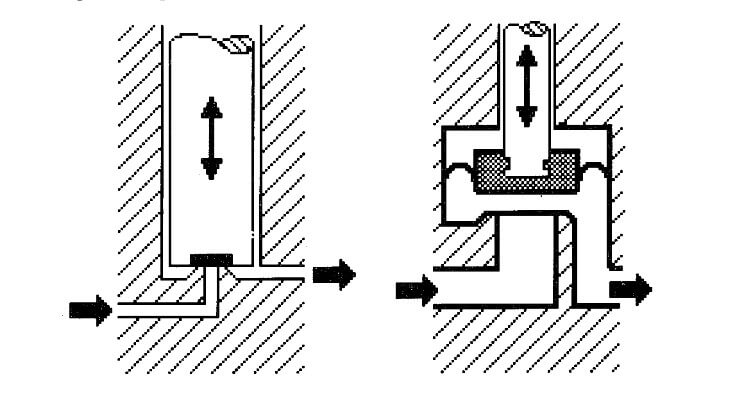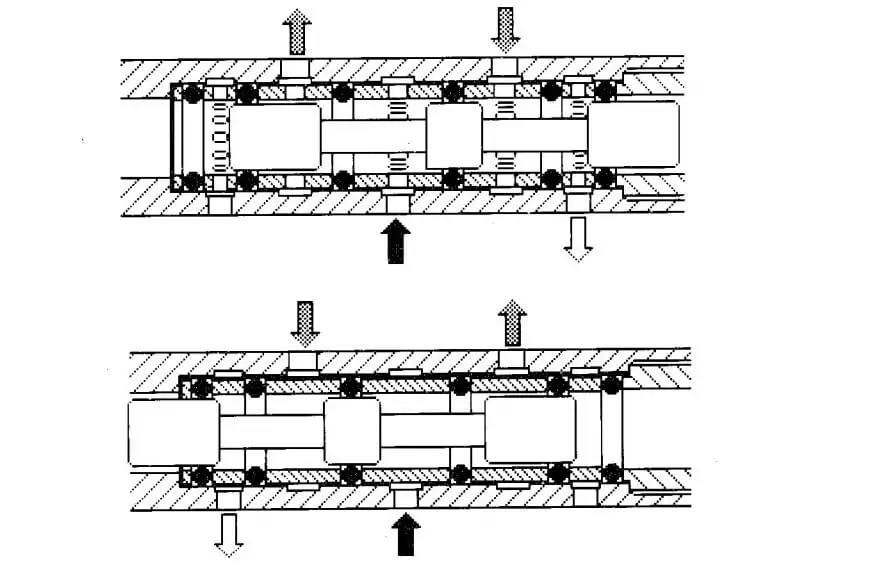Valves are essential components in every pneumatic system, providing a method by which the air flow to or from other devices can be accurately controlled.
The following chapter looks at the types of valve that are available and explains the differences between the various techniques employed to improve performance and reliability.
Basic Requirements
Before considering the different types of valve, it is important to understand the basic operational specification that every valve should meet. In general terms these are as follows:
i) Long operating life, under a variety of conditions.
ii) Constant and fast response times.
iii) High flow characteristics.
iv) Ease of maintenance.
To achieve this combination of features, the valve must provide an efficient method of switching air between inlet and outlet ports, with no internal leaks and using a minimum of energy to carry out each switch movement.
In addition, the mechanism which directs the air flow should be constructed so that frictional forces are minimised and a positive location is provided in each operating position. Finally, it is desirable for the valve to have an action such that lubricants are not removed by the sliding action of internal components.
Valve Types
There are two main types of valve: poppet and spool. These can be further classified by the method of actuation: mechanical or air pilot and solenoid.
Poppet Valves
Poppet valves incorporate a manual or mechanically operated plunger, which is normally held in the closed position by a spring or by air pressure. Depressing the plunger opens the valve and allows air to flow.
A seal is achieved between the plunger and the valve seal by means of flat discs and washers, O-rings or spherical closures.

One of the main advantages of poppet valves is their relative simplicity, with a minimum of moving parts. They are also self-cleaning, using the purging effect of the air flow, and require little maintenance.
Although poppet valves have a short stroke before maximum flow is achieved, they can only be operated in an open or closed position, making it difficult to regulate the flow path through the valve.
Poppet valves are not suitable for complex switching operations, where a combination of inputs and outputs are required. They can also be affected by fluctuations in input pressure, which increases or decreases the actuation force needed to open the valve seal.
Spool Valves
In essence, a spool valve uses a specially profiled rod or spool, sliding longitudinally within the centre of the valve, to switch the air flow between different inlet and outlet ports.
The direction of air flow is at right angles to that of the spool. The spool can be moved manually or by means of an air pilot or electrically operated solenoid.
Spool valves offer a considerably higher level of functionality than poppet valves and are unaffected by changes in operating pressure, enabling response times to remain constant.
Spool valves can provide a highly effective method of controlling air flow to and from other pneumatic devices. The level of performance or efficiency which can be achieved, however, is directly related to the design and manufacture of the spool itself. As a result, a number of variations have been developed.
Spool Design
The spool slides within the barrel of the valve. Cut into the barrel are the various port openings, with the machined profile of the spool providing flow paths across different ports, depending on the position of the spool.
The critical factors affecting valve performance are therefore as follows :
i) Friction between the spool and the barrel.
ii) The force required to move the spool.
iii) The leakage of air around the spool. In particular, at the point where the spool seals each port opening.
iv) The affect of contamination.
O-ring Spools
Traditionally, spools have been manufactured from crimped stainless steel or turned aluminium, with nitrile rubber Orings either being fitted into grooves on the spool, with spacers added to keep them in position, or within plastic or metal cages mounted on the inside face of the barrel.
In each case, however, the O-rings create a number of problems.

The most common problems relate to the wide tolerance band within which O-rings are often manufactured. At one extreme, this will result in a seal which is too loose, with poor location allowing air to bleed between the O-ring and, depending on the type of valve, the barrel or the spool;
conversely, if the O-ring is too large then it will dramatically increase the level of friction and hence the actuation force necessary to move the spool. (The term commonly applied in this context is ‘stiction’).
As the O-ring is contained on three sides, by the body of the valve and by spacers, changes in temperature or contamination can also affect its efficiency. The O-ring can either expand, leading to an increase in stiction, or contract, resulting in leakage.
Continuous operation at very low temperatures will also cause the seal to become hard. The physical characteristics of the rubber will similarly deteriorate if there are contaminants, such as compressor oil, within the air system.
The use of O-rings and the various spacers, or other mechanisms designed to hold them in position, account for a significant proportion of the available spool area, thereby limiting the amount of space available for the air flow between ports.
The alternative to restricted air flow is to increase the overall size of the valve, which in many applications is an unacceptable solution.
Elastomer Bonded Spools
To overcome many of these problems elastomer bonded spools were developed. These comprise a metal core, to which a thin coating of elastomer is vulcanised.
The coating is then chemically hardened and match ground to a fine tolerance, producing a seal material with superior elasticity and compression properties.

The elastomer bonded seal provides a number of significant advantages over conventional O-ring devices.
There is only a small number of moving parts, so reliability is considerably improved. In addition, the elastomer is thinly coated, by applying it the spool and allowing it to set, before it is frozen and ground to match the valve body.
Dimensional changes, due to fluctuations in temperature or the ingress of contaminants, therefore have little effect on the efficiency of the valve.
And, unlike the O-ring arrangement, the seal material is not constrained in any one dimension, so expansion or contraction occurs vertically as well as laterally. Stictional forces are, therefore, almost eliminated.
As the spool comprises a single component it is possible to make the airways considerably larger, thereby increasing air flow or reducing the overall size of the valve.
Additionally, the profile of the spool is such that it is unnecessary for the sealing ridges fully to transverse their respective port opening before optimum air flow is achieved. Consequently, both spool travel and seal wear are reduced.
Finally, both spool and barrel are designed so that there are no groves or holes in which solid contaminants can collect; particles that do enter the valve being removed by the flow of air.
Although elastomer bonded spool valves offer many advantages over conventional O-ring devices, they are still prone to wear, albeit on a much smaller scale, with a typical life of around 20 million cycles
Stainless Match Ground Spool and Sleeve Valve
Valves incorporating an all-metal match-ground spool, set within a sleeve, provide an operating life in excess of 100 million cycles.
Perhaps as importantly, they have exceptionally short spool travel and require minimal force to move the spool. This allows direct solenoid actuation, with power consumption as low as 1.8 Watts.

The spool and sleeve are separated by a gap of 3.0 microns. Although this allows air to leak from the system it also acts in the same way as a frictionless air bearing, providing a long operating life, fast response times and accounting for the low forces necessary to move the spool. Short spool stroke and high flow rates are enhanced by using different diameter radial holes machined into the sleeve.
The sleeve is mounted on a series of static O-rings, making the entire assembly immune to vibration, distortion or changes in temperature.
Although the system can be affected by a build up of fine dust between the spool and sleeve, the sharp edges of the spool generally prevent particles from becoming trapped. If maintenance is required, the entire assembly is easily removed for cleaning. The only other drawback is, of course, a slow but continuous air loss.
Source : smc.eu